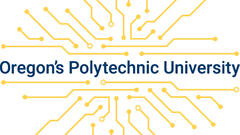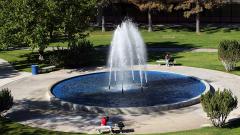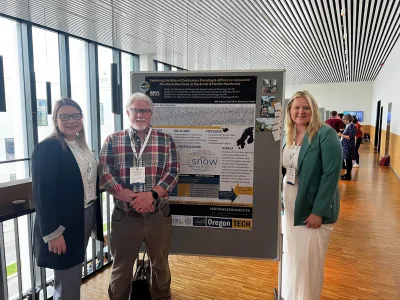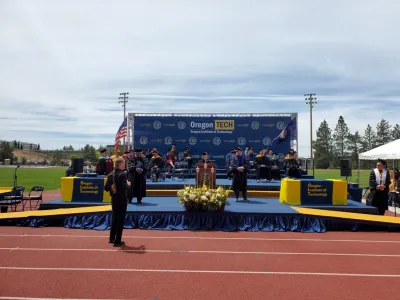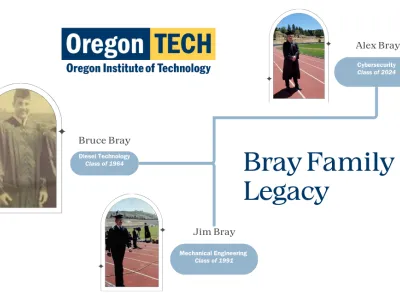After the creators of the STEM&M initiative at Mazama High School gave a presentation at a national conference in Washington, D.C., several audience members said they liked the uniqueness of the program, and one college said they wanted to bring it to their community. “They pretty much said they wanted to copy our program,” said Mazama High School Principal Steve Morosin.
STEM&M is the partnership between Mazama High School and Oregon Tech that focuses on Science, Technology, Engineering, Math and Medical. It was different from the other programs highlighted at the National Alliance of Concurrent Enrollment Partnerships. Most programs are run the same way all around the country: colleges provide programs which high school teachers instruct for students to earn college credit. “None take the next step of collaboration we’ve found,” said Laura Nickerson, Mazama STEM&M creator and program lead.
Through the partnership with Oregon Tech, STEM&M offers more to its Mazama students. While students are in high school, they follow specific pathways toward college degrees and careers. STEM&M offers extra incentives like guest speakers and field trips. After high school, it offers $9,500 in total scholarships to Oregon Tech and preferential admission into Oregon Tech programs if students choose to go there after high school.
A team from the Klamath County School District and Oregon Tech attended and presented at the conference in Washington, D.C., from Oct. 7 through 12. Marla Edge, director of academic agreements, and Grace Rusth, academic partnerships coordinator, represented Oregon Tech and invited Morosin and Nickerson to participate in the STEM&M presentation. They were joined by KCSD secondary curriculum director Jeff Bullock.
“Presenting STEM&M at NACEP this year was a phenomenal experience,” shared Rusth. “Since the inception of STEM&M two years ago, everyone I have talked to across Oregon loves the program: school administrators at both the high school and collegiate level want to replicate STEM&M at their school, parents want their children to participate, and students talk about how they can get into STEM&M.”
While in the capitol, the team also took a course in lobbying and spent one day speaking in support of education to the staff of Rep. Greg Walden, R-Ore., and Sen. Ron Wyden, D-Ore.
STEM&M today
STEM&M is well into its second year of operation, with three classes of students participating. This spring it will start its third year and the fourth class will sign on. Students enroll as freshmen during official signing ceremonies and start the program in their sophomore year. The first year was an exception, when two classes signed on as freshmen and sophomores. In April 2016, the first group of students to sign were the class of 2018 and the class of 2019. In March 2017, the class of 2020 became the third. In all, 85 students are in STEM&M at Mazama. Once in the program, students have to continue to meet a high bar. Their GPA must be 3.0 or better, they must participate in STEM&M activities to earn points and they earn a minimum 10 Oregon Tech college credits and take the SAT or ACT.
Of those who initially signed on, there have been 14 who withdrew from the program, but none due to low grades. Some dropped due to schedule conflicts, some moved out of the area and some wanted to pursue other college choices.
Demographics
Those positive numbers on enrollment and retention are part of what the STEM&M team presented in Washington, D.C. What is even more impressive, Nickerson said, is how well the demographics of the students participating in STEM&M match the overall demographics of Mazama. It’s not just males signing up (more than half, 58 percent, are females). And it’s not just affluent students. All students are interested enough to start the program and have the grit to do the work to stay in.
“If you look at the signing classes we’ve had, and you look at our school demographics, our signing group are within about one or two percent of our school demographics,” Nickerson said. “It is a startling pie chart. It’s like a mirror.”
Why such close correlation? Nickerson and Morosin said it says more about Mazama students than the program itself. “Our minorities are equally dispersed just like the rest of our kids. We don’t really think of them as minorities, and I don’t think they think of themselves as minorities,” Nickerson said. “It’s just like, let’s roll. I’m interested in science, so let’s do this.”
Morosin also credited support from the Mazama staff, the district administrators and everyone at Oregon Tech. “The people teaching the courses are excited about it, which makes the kids excited about it, and the district’s excited about it,” he said. “It all snowballs into one good thing after another.”
Coming up next
When Nickerson is out and about in the Klamath Basin, she is known for STEM&M. People approach her to talk about the program. That helps get the next class of students interested, she said. “Having the opportunity to share what Klamath Falls is doing at a national venue was humbling,” Rusth said. “I knew STEM&M was something special from the first planning session, but the validation that others outside of our area do too was just amazing. STEM&M style programs are the next big idea in concurrent enrollment, I imagine we will see more and more partnerships like this in the future – and I hope we do.”
In spring 2018, this year’s freshmen will be invited to apply for STEM&M. They are the class of 2021. “Some of them are like, ‘I’ve been planning on applying since I heard about it.’ And they’re asking me on the first day of school, ‘When are applications?’” Nickerson said. “Our freshmen who apply this year were seventh graders when we first started it.”
STEM&M will begin receiving applications in February from Mazama students, or other students in the Klamath County School District and other districts who might want to switch to Mazama for the program. Learn more about STEM&M on the program’s website, or see updates on its Facebook page.
Local STEM&M leaders present at national conference
-
Klamath Falls
Tarrah Bickford presenting at IdeaFest in Klamath Falls
Oregon Tech…
-
All Locations
The Oregon Institute of Technology Klamath Falls Class of 2024 moved its mortarboard tassels to the left as President Nagi Naganathan, Ph.D.,…
-
All Locations

